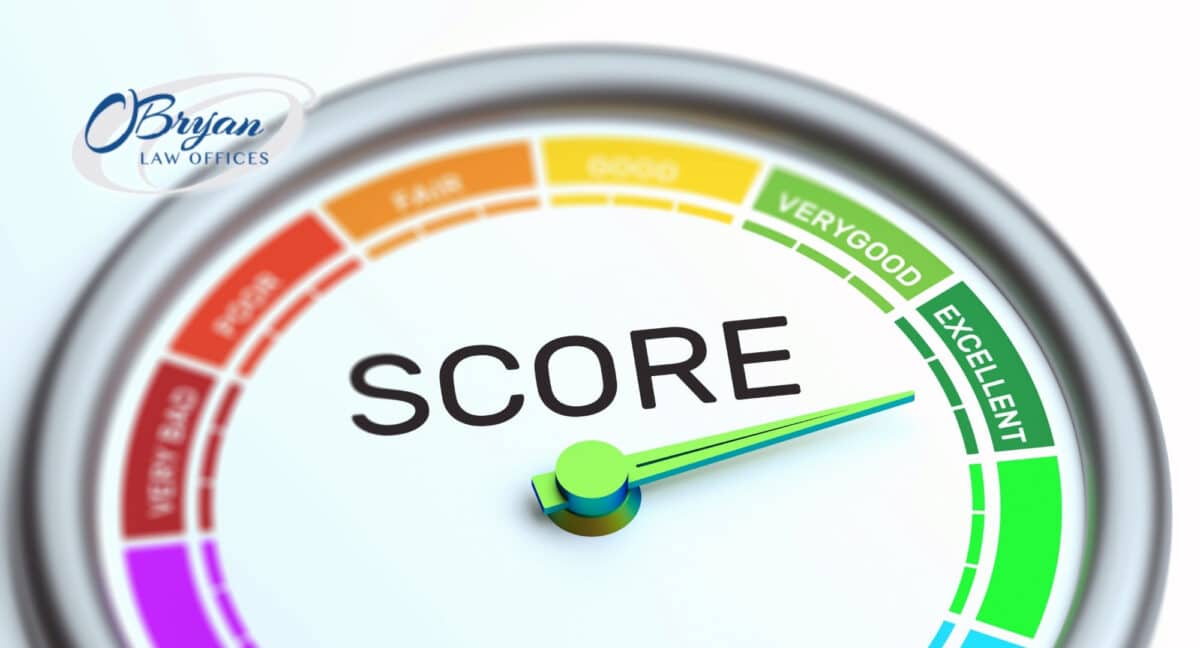Credit Score Ranges

Home » Life After Bankruptcy » Restoring Credit » Credit Score Ranges
Understanding Your Credit Score

Although a credit score is just three digits long, it may have a major influence on your financial situation. Your credit score ranges (most individuals have several) might influence your ability to qualify for a loan, obtain a credit card, or how high your credit limits and interest rates will be. Credit scores do this by indicating to potential lenders how likely you are to repay your loans. Understanding credit score ranges will assist you in determining whether or not your credit needs to be improved. Knowing what influences your credit ratings may also help you figure out how to improve them over time.
At O’Bryan Law Offices, we put our deep understanding of credit and bankruptcy to work for our clients. Whether they seek to file for bankruptcy to rearrange their finances, or if they just need debt counseling, we’re here to help. A dedicated Louisville bankruptcy attorney will guide you through every step of the process and ensure that you emerge in a better position. For more information, or to schedule your free consultation, please call 502-339-0222 today.
What Is a Credit Score?
A credit score is a number calculated using data from your credit reports. The majority of credit scores lie between 300 and 850, and where your score falls within this range indicates your assessed credit risk. In other words, it informs potential lenders about your likelihood of repaying a loan.
Your credit score ranges may influence whether or not you are approved for a mortgage, vehicle loan, personal loan, credit card, or other kind of credit. Your credit scores can also influence the loan rate and conditions you’re provided if you’re accepted.
How Credit Scores are Calculated on a Credit Report
The information in your credit reports is used to determine your credit score. Equifax, Experian, and TransUnion, the three credit bureaus that most businesses look to, each create a credit report based on information from lenders, credit card issuers, and other financial organizations.
Your credit reports provide details about your credit history and usage. Credit scoring algorithms like VantageScore and FICO are used by credit bureaus to convert all of this data into a score.
While each credit scoring model has its own methodology, they all take into account comparable credit data. Your credit scores are usually determined by criteria such as your payment history, the amount of credit you have accessible, and the sorts of debt you have. We’ll go over these in more depth later.
Personal information such as your race, gender, religion, marital status, or national origin cannot be used into credit ratings under federal law. However, it isn’t always true that the American financial system is unbiased, or that credit lending and credit rating systems don’t take prejudice into account.
Why Do I Have Different Credit Scores?
Having various credit ratings from multiple credit bureaus is entirely acceptable.
Here are a few possible explanations for the disparity in your credit ratings:
- Different credit scoring models: As previously stated, multiple credit scoring models may be used by the credit bureaus to generate your ratings. Because various scoring models use different ranges and component weightings, the results are frequently inconsistent.
- Lenders using different types of credit scores for different types of loans: An auto lender, for example, may employ a credit score tailored to the auto sector. These ratings are very different from normal credit scores for consumers.
- Lenders might report to only one or two credit bureaus: This implies that information that might boost or reduce your credit score could be absent from a credit reporting bureau.
- Lenders report updates to each credit bureau at different times: If one credit agency has more up-to-date information than the other, your scores may differ.
You’ll notice slight swings and variances on your credit report as a byproduct of all of these factors. Instead of concentrating on these little changes, think of your credit scores as a meter of your overall credit health, and examine how you might improve your credit over time.
You can dispute mistakes on one or more of your credit reports with each credit agency if you believe your credit scores are different because of errors on one or more of your credit reports.
What is the Difference Between FICO Score and VantageScore?
There are two companies that ultimately dominate the credit industry in credit scoring. The FICO credit score is the most widely known and used credit score, and its main competition is the VantageScore.
They both use the credit score range starting at 300 and going up to 850.
FICO and VantageScore have their own separate versions of how they score credit. Both actually have multiple versions of their scoring model, as well. For consumer credit scores, the most popular scoring model is FICO 8 and VantageScore 3.0.
While VantageScore and FICO pull the exact same data from credit reporting agencies, they weigh the information differently. And, the credit scores typically move in tandem with one another. So, if you have a high credit score with VantageScore, you’re likely to have a high credit score with FICO, too.
What Are Credit Score Ranges?
Knowing where your credit score sits in the FICO and VantageScore categories may help you figure out if you’ll be approved for a loan or credit card, as well as what type of rate you’ll get.
The VantageScore and FICO models differ in a few significant ways, including how they prioritize various criteria in establishing your ratings. Both have a score range of 300 to 850, but their definitions of poor, fair, good, and excellent differ.
Credit Score Ranges | VantageScore | FICO |
Excellent | 781-850 | 800-850 |
Very Good | N/A | 740-799 |
Good | 661-780 | 670-739 |
Fair | 601-660 | 580-669 |
Poor | 500-600 | <580 |
Very Poor | <500 | — |
What is the Perfect Credit Score?
The highest credit score that one can achieve is an 850. It’s important to note that there isn’t much difference between a perfect credit score and an excellent credit score in terms of rates that you can apply for. In layman’s terms: don’t stress yourself out trying to achieve the perfect, 850 credit score, especially considering that even good credit scores can range drastically.
What is a Good Credit Score and How Does it Affect My Credit Report?
So, what exactly constitutes a good credit score? A credit score of 670 or more is typically regarded as acceptable, however it varies per credit scoring methodology. A good FICO score is between 670 and 739. A score of 661 to 780 is considered good by VantageScore.
Excellent credit scores or even good credit scores will make a world of difference in terms of financial gain. When assessing a loan or credit application, financial organizations evaluate a range of criteria, but higher credit scores are typically associated with a higher probability of approval.
A good credit score might also lead to cheaper interest rates and more favorable terms. And if your credit score is great, you’ll have an even higher chance of getting the finest prices and conditions. If you’re looking to buy a home or car, then having a FICO credit score within the good credit score range will help you qualify and get a better interest rate.
If you have poor or very poor credit, on the other hand, you may be accepted by some lenders, but your rates will almost certainly be considerably higher than if you had good credit. You may also be asked to put down a deposit or obtain a cosigner on a loan.
What is the Average Credit Score Range?
In the United States, the average credit score varies, depending on which credit scoring model you’re using.
The average FICO score is typically around 716 and the average credit score for VantageScore is 696.
What is a Fair Credit Score?
Having a fair credit score will typically put you right in the middle of the credit score ranges. So, most of the United States falls into the average or fair credit score range.
The fair Fico Score range is between 580 and 669, and the credit score range for VantageScore is between 601 and 660.
Ultimately it’s up to the credit card issuer, auto lenders, or whoever is lending the money to determine what a fair credit score is using either the two credit scoring models mentioned or custom credit scoring models.
Factors That Affect Your Credit Score
Individual components differ depending on the credit-scoring methodology employed. However, your credit ratings are influenced by these variables in general.
Payment History
The payment history of on-time payments is the most significant element in calculating your credit ratings for both the FICO and VantageScore scoring models. A lender or creditor uses your payment history to determine how likely you are to repay a debt.
Late or missed payments can certainly wreak havoc on a good credit score. Payments that are late by 30 days or more will cause your credit score to drop.
Credit Usage or Credit Utilization Rate
Your credit utilization or credit usage is another highly important aspect of your credit score.
Divide your overall credit card balances by your total credit limits to get your credit usage or utilization. A greater credit utilization rate may indicate to a lender that you have too much credit card debt and will likely be unable to repay your new loan or credit card amount. Keep your credit usage percentage below 30% of your available credit limit according to the Consumer Financial Protection Bureau.
Credit History
The length of your credit history is a fairly important factor when determining your credit score. A longer credit history might help you improve your credit ratings by demonstrating that you have more credit experience. Your credit history contains the number of credit accounts you have and when they were last utilized. Avoid canceling older accounts if at all possible, as this may diminish your credit history.
Types of Credit
The types of credit and mix of credit types is also a fairly important factor in calculating your credit score.
A balanced combination of accounts, such as revolving lines of credit (credit cards) and installment loans (auto loans, school loans, personal loans, and mortgages), can help you improve your credit ratings. Lenders want to know that you can handle and repay various forms of credit.
Credit Inquiries
A less important factor includes recent credit inquiries.
When you ask for credit or a loan, the financial institution will run a hard credit inquiry, which will appear on your credit reports. Opening several new accounts in a short period of time might indicate to a lender that you’re having financial difficulties.
How to Improve Your Credit Score
Credit scores measure one thing: creditworthiness. But, what does this even mean?
Credit scores are an attempt to measure or predict a person’s financial behaviors. They offer financial protection to credit card companies and affect lending decisions every day.
The same factors that are used to determine your credit standing are also the same factors you’ll need to use to raise your credit score:
- Pay all bills on time. If you can’t pay all of your bills on time, start with the bills that have the highest interest rates.
- Stay within 30% of your credit limit. Those who are able to pay off credit card debt every month may be able to apply for higher credit limits. However, it’s important to note that a higher credit limit does not equal a higher credit score.
- Keep your older credit cards open. This will help boost the average age of your credit accounts.
- Consider having a good credit mix. A credit mix is a mixture of credit cards and installment loans.
Credit Counseling to Improve Credit Scores
Getting the hang of managing your credit might seem like a daunting task at first, but it gets easier with time. With the help of a certified credit counselor in Kentucky, O’Bryan Law Offices will help you get your finances in order. We have extensive experience in this area of law, so you can rest assured that you’re in good hands. We will even help you to rebuild your credit score after filing for bankruptcy. To schedule a free consultation with one of our attorneys, please call 502-339-0222 today.






